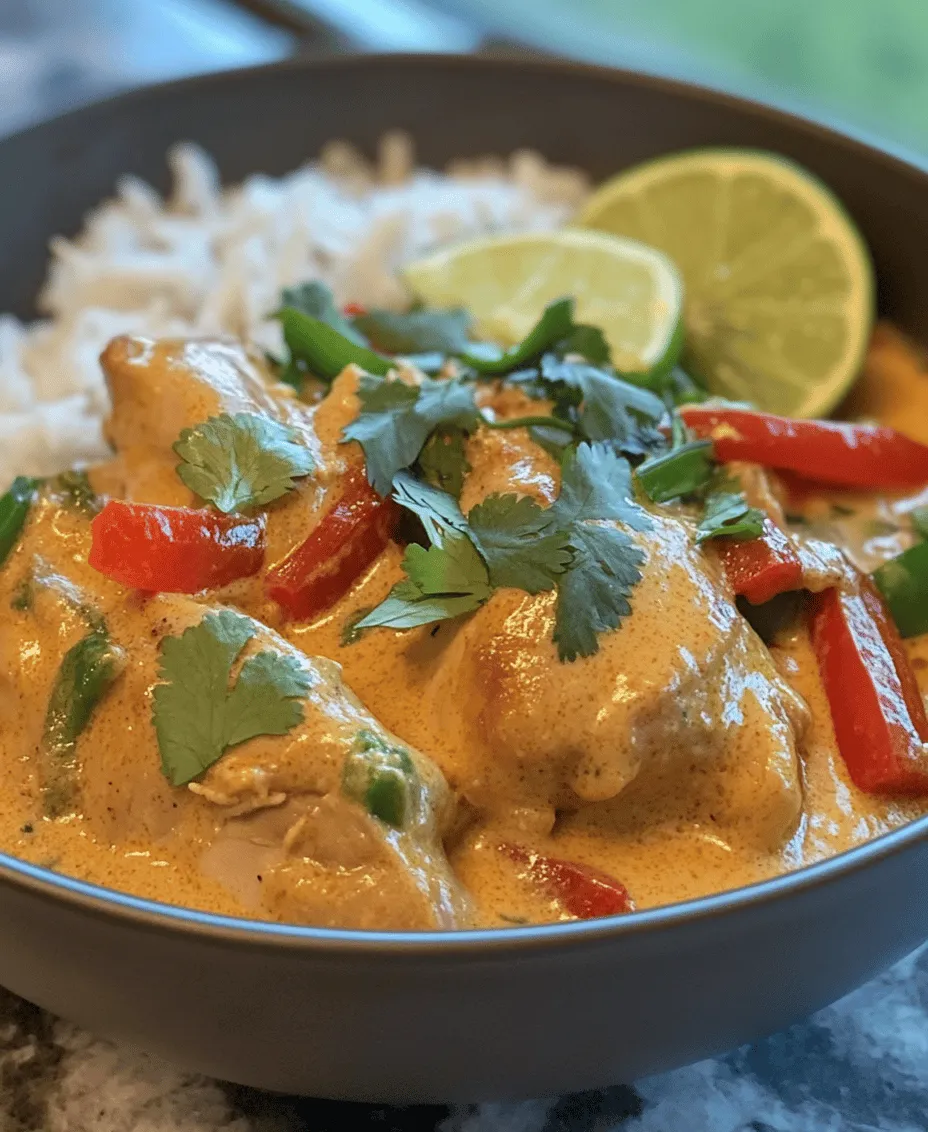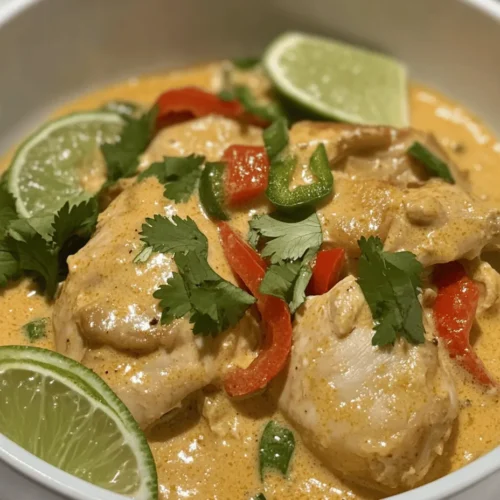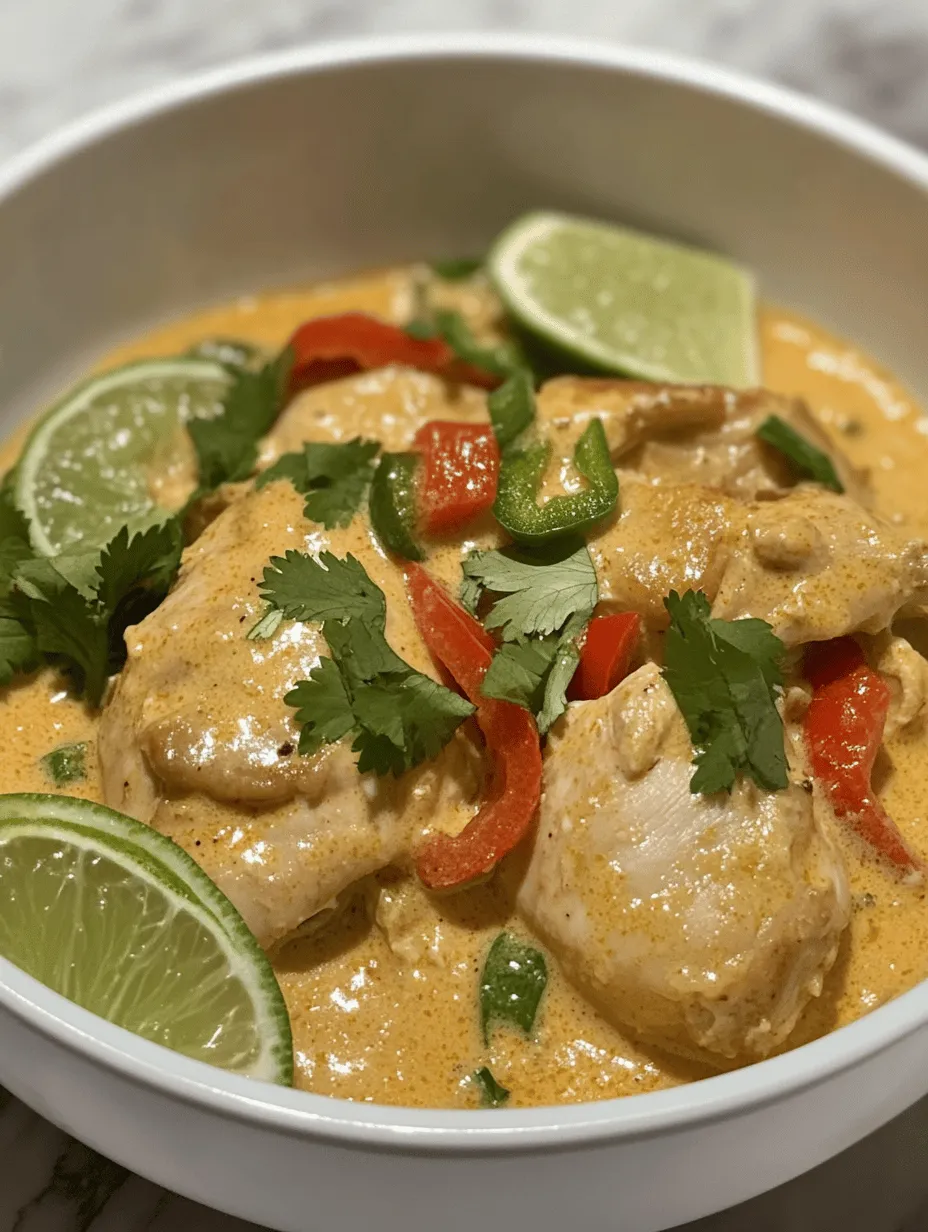Introduction
Brazilian cuisine is a vibrant tapestry of flavors, colors, and cultures, woven together from indigenous traditions and influences from Europe, Africa, and Asia. Known for its bold and diverse culinary landscape, Brazilian dishes often highlight the country’s rich natural resources and the warmth of its people. Among the many delightful offerings of Brazilian gastronomy, one recipe stands out for its enticing blend of spices and creamy coconut milk: Spicy Brazilian Coconut Chicken. This dish captures the essence of Brazilian cooking, showcasing a unique combination of ingredients that create a symphony of flavors sure to please spice lovers and culinary adventurers alike.
Spicy Brazilian Coconut Chicken is not just a meal; it’s an experience that evokes the vibrant atmosphere of Brazilian festivals and family gatherings. The dish features tender chicken marinated in a medley of spices, then cooked in a luscious coconut milk sauce, resulting in a rich, aromatic dish that is both comforting and exciting. Whether you’re hosting a dinner party or simply looking to elevate your weeknight meals, this recipe is sure to impress anyone who has the pleasure of tasting it.
Understanding Brazilian Cuisine
Brazilian cuisine is a reflection of the country’s diverse cultural heritage, where food plays a significant role in social gatherings and celebrations. Meals in Brazil are often communal, bringing families and friends together to share delicious dishes that embody the spirit of togetherness. The culinary landscape is marked by a variety of regional specialties, influenced by local ingredients and historical contexts.
Key Ingredients Commonly Used in Brazilian Dishes
Brazilian cooking relies heavily on fresh, locally sourced ingredients. Staples such as rice, beans, and manioc (cassava) form the base of many traditional meals. The use of tropical fruits, vegetables, and herbs adds brightness and depth to dishes, while the incorporation of spices creates a harmonious balance of flavors.
Among these key ingredients, coconut and spices hold a special place in Brazilian cooking. Coconut, in particular, is a versatile ingredient that brings a creamy texture and subtle sweetness to both savory and sweet dishes. Spices like cumin, coriander, and paprika are frequently used to enhance the taste and aroma of meals, making them irresistible. The combination of coconut with aromatic spices creates a sensational flavor profile that is characteristic of many Brazilian recipes, including Spicy Brazilian Coconut Chicken.
Ingredients Breakdown
To create the perfect Spicy Brazilian Coconut Chicken, it’s essential to gather high-quality ingredients that will elevate the dish’s flavors. Here’s a detailed breakdown of the key ingredients you will need:
1. Chicken: The star of this dish. Choose bone-in, skin-on chicken thighs for maximum flavor and tenderness. The skin adds richness, while the bone helps keep the meat moist during cooking. If you prefer a lighter option, boneless, skinless chicken breasts can be used, but be sure to adjust cooking times accordingly.
2. Coconut Milk: This creamy component is essential for achieving the dish’s signature flavor and texture. Look for full-fat coconut milk for a richer sauce. If you’re looking for a dairy-free alternative, ensure the coconut milk is free from additives and preservatives.
3. Onions and Garlic: Aromatics play a crucial role in building the flavor base of this dish. Use yellow or white onions for sweetness, and fresh garlic for its pungent aroma. Both should be finely chopped to allow for even cooking and flavor distribution.
4. Spices: A blend of spices is what sets this dish apart. Common spices used include cumin, coriander, turmeric, and paprika. Each spice contributes its unique characteristics, creating a warm and aromatic profile. For those who enjoy heat, cayenne pepper or chili powder can be added for an extra kick.
5. Jalapeños: Fresh jalapeños add both heat and flavor to the dish. Adjust the amount according to your spice tolerance, and remember to remove the seeds for a milder taste, or leave them in for a fiery punch.
6. Fresh Herbs: Cilantro or parsley can be used as a garnish to add freshness and color. These herbs not only enhance the visual appeal but also provide a burst of flavor.
Importance of Fresh Ingredients for Authentic Flavor
Using fresh ingredients is vital for achieving the authentic taste of this dish. Fresh herbs, spices, and produce enhance the overall flavor profile and provide a vibrant quality that dried or processed alternatives cannot replicate. For the best results, consider visiting local farmer’s markets or specialty grocery stores to source the freshest ingredients available.
Substitutions for Common Ingredients
While this recipe calls for specific ingredients, there are some substitutions you can make if needed. For instance, if you cannot find coconut milk, you can use unsweetened almond milk mixed with a little coconut extract for a similar flavor profile. If chicken thighs are not available, you can use drumsticks or even tofu for a vegetarian version. Just be mindful of cooking times, as different proteins will require different preparation methods.
Marinating the Chicken
Marinating the chicken is a crucial step in this recipe, as it infuses the meat with flavor and helps to tenderize it. The marinade consists of a blend of spices, garlic, and lime juice, which not only adds depth to the dish but also helps to break down the proteins in the chicken, resulting in a more succulent final product.
Explanation of the Marination Process and Its Benefits
To marinate the chicken, you’ll want to combine your chosen spices, minced garlic, and fresh lime juice in a bowl. Coat the chicken thoroughly with the marinade, ensuring every piece is evenly covered. The acidic nature of lime juice helps to tenderize the chicken while enhancing its flavor.
Insight into How Each Marinade Ingredient Contributes to Flavor and Tenderness
– Spices: Each spice in the marinade adds its own unique flavor profile. Cumin brings warmth, coriander adds a citrusy note, and paprika contributes sweetness and color. Together, they create a well-rounded flavor that permeates the chicken.
– Garlic: Fresh garlic adds a punch of flavor and aroma that elevates the dish, making it more aromatic and appealing.
– Lime Juice: The acidity from the lime juice not only brightens the flavors but also helps to tenderize the chicken, ensuring that it remains juicy during cooking.
Recommended Marinating Times for Optimal Results
For optimal flavor infusion, allow the chicken to marinate for at least 30 minutes. However, if you have the time, marinating for 2-4 hours (or even overnight in the refrigerator) will yield even more pronounced flavors. Just be sure to bring the chicken to room temperature before cooking for even cooking throughout.
Sautéing Aromatics for Depth of Flavor
Once the chicken has been marinated, the next step involves sautéing aromatics to build a rich flavor base for the dish. Aromatics like onions and garlic are foundational components of many cuisines, and Brazilian cooking is no exception. They provide an essential depth of flavor that complements the spices and coconut milk.
Importance of Aromatics in Building Flavor
Sautéing onions and garlic releases their natural sugars, resulting in caramelization, which adds sweetness and complexity to the dish. This step is crucial in developing the overall flavor profile of Spicy Brazilian Coconut Chicken.
Step-by-Step Guide to Sautéing Onions and Garlic
1. Heat Oil: In a large skillet or Dutch oven, heat a couple of tablespoons of olive oil or coconut oil over medium heat. The oil should be hot but not smoking.
2. Sauté Onions: Add the chopped onions to the skillet and sauté until they become translucent and slightly golden, about 5-7 minutes. Stir occasionally to prevent burning.
3. Add Garlic: Once the onions are ready, add the minced garlic and sauté for an additional minute until fragrant. Be careful not to let the garlic burn, as it can turn bitter.
4. Incorporate Jalapeños: If you’re using jalapeños, add them to the skillet at this stage. Sauté for another 2-3 minutes to allow their flavors to meld with the onions and garlic. The heat from the jalapeños will infuse into the oil, enhancing the overall spiciness of the dish.
Discuss the Impact of Adding Jalapeños and Their Influence on the Dish’s Heat Level
Jalapeños bring a fresh, bright heat to the dish that balances the richness of the coconut milk. The level of heat can be adjusted by controlling how many jalapeños you use and whether or not you include the seeds. This flexibility allows you to customize the spice level to your preference, making this dish accessible to a wide range of palates.
By mastering the art of sautéing aromatics and understanding the impact of each ingredient, you are well on your way to creating a vibrant and flavorful Spicy Brazilian Coconut Chicken that showcases the best of Brazilian cuisine.
In the next part of this article, we will explore the process of cooking the chicken to perfection, ensuring that each bite is tender, juicy, and bursting with flavor.

Techniques for Searing Chicken Thighs for Maximum Flavor
Searing chicken thighs is an essential technique for maximizing flavor in your Spicy Brazilian Coconut Chicken. The goal is to develop a beautifully browned crust that enhances the overall taste of the dish. Start by ensuring your chicken thighs are at room temperature. This allows for even cooking and better browning. Pat them dry with paper towels to remove excess moisture, which can prevent searing.
Heat a heavy-bottomed skillet or cast-iron pan over medium-high heat and add a splash of high-heat cooking oil (such as canola or avocado oil). Once the oil shimmers, place the chicken thighs skin-side down in the hot pan. Avoid overcrowding the pan, as this can cause the chicken to steam rather than sear. Cook for about 5-7 minutes without moving them, until the skins are golden brown and crispy.
Flip the chicken thighs and cook for an additional 5-7 minutes on the other side. The Maillard reaction, which occurs during this process, is critical for creating complex flavors. Once properly seared, remove the chicken from the pan and set it aside to rest while you prepare the sauce. This resting period allows the juices to redistribute, ensuring a moist and flavorful end result.
The Science Behind Cooking Chicken Evenly and Ensuring It Remains Juicy
When preparing chicken, it’s not just about the sear; the cooking process must ensure that the meat remains juicy and tender. The key to achieving this is to cook the chicken at a consistent temperature. Ideally, you want to maintain a medium to medium-low heat after searing to allow the chicken to cook through without drying out.
Using a meat thermometer is the best way to monitor doneness. Chicken thighs should reach an internal temperature of 165°F (75°C) in the thickest part of the meat. However, for even juicier results, you can cook them to a higher internal temperature of around 175°F (80°C). At this temperature, the collagen in the meat breaks down, creating a tender texture.
Additionally, consider using a lid during the simmering process. This helps retain moisture and creates a steaming effect, which promotes even cooking. If you find the chicken is browning too quickly, reduce the heat or add a splash of water to the pan to prevent burning.
Tips for Monitoring Doneness While Cooking
Monitoring doneness while cooking is crucial to ensure that your chicken is perfectly cooked. Invest in a good meat thermometer; it’s an invaluable tool for any kitchen. Insert the thermometer into the thickest part of the chicken thigh, avoiding the bone for an accurate reading.
If you prefer a more tactile approach, you can also check for doneness by pressing the chicken lightly with a fork or your finger. If it feels firm and the juices run clear, it’s likely done. Conversely, if it’s still soft and the juices are pink, it needs more cooking time.
Another useful technique is to cut into the chicken at its thickest point. If the meat is opaque and no longer pink, it’s ready to be enjoyed. Remember to let the chicken rest for a few minutes after removing it from the heat; this allows the juices to settle, ensuring a juicy bite.
Incorporating Vegetables
Adding vegetables like bell peppers and jalapeños to your Spicy Brazilian Coconut Chicken not only enhances the flavor but also boosts the nutritional value of the dish. Bell peppers add a sweet crunch and vibrant color, while jalapeños introduce a spicy kick that complements the coconut’s creaminess.
Benefits of Adding Bell Peppers and Jalapeños to the Dish
Bell peppers are rich in vitamins A and C, making them a healthy addition. Their natural sweetness balances the spiciness of jalapeños, creating a well-rounded flavor profile. Jalapeños, on the other hand, provide a delightful heat that can be adjusted to your preference—simply remove the seeds for a milder flavor or keep them for a spicier dish.
The combination of these vegetables contributes to a more complex flavor and texture in your chicken dish. They also add visual appeal, making your meal more enticing.
How to Balance Flavors with Fresh Vegetables
When incorporating fresh vegetables, it’s important to balance their flavors with the spices and coconut milk in your dish. Start by sautéing the vegetables in the same pan where you seared the chicken. This allows them to absorb any leftover flavors from the chicken, enhancing the overall taste.
Cook the vegetables until they begin to soften, about 3-5 minutes, before adding them to the chicken and sauce. This method ensures that the vegetables retain some crunch and do not become overcooked, providing a delightful contrast to the tender chicken.
Suggestions for Additional Vegetables That Could Complement the Dish
While bell peppers and jalapeños are fantastic choices, consider adding other vegetables that complement the flavors of your Spicy Brazilian Coconut Chicken. Zucchini, snap peas, or even corn can introduce unique textures and flavors. Baby spinach or kale can be stirred in just before serving to add a pop of color and nutrients.
Creating the Sauce
The coconut milk marinade serves as the backbone of your sauce, infusing the chicken with rich flavor while keeping it moist. The creaminess of the coconut milk balances the spices, creating a harmonious blend that is quintessential in Brazilian cuisine.
Importance of the Coconut Milk Marinade as a Sauce Base
Coconut milk is not only a key ingredient but also acts as a base for your sauce, marrying all the flavors together. Its natural sweetness complements the heat from the spices and the acidity from any added lime juice, creating a well-balanced dish that tantalizes the taste buds.
Step-by-Step Process for Incorporating the Marinade into the Dish
To incorporate the marinade into your dish, start by returning the seared chicken to the pan. Pour the coconut milk marinade over the chicken, ensuring that each piece is well-coated. Bring the mixture to a gentle simmer, allowing the chicken to cook through while absorbing the flavors of the sauce.
Stir occasionally and monitor the heat to prevent the sauce from boiling too aggressively. A gentle simmer is ideal for developing flavors without losing the creaminess of the coconut milk. This process typically takes about 15-20 minutes, depending on the size of your chicken thighs.
Tips for Achieving the Desired Consistency of the Sauce
To achieve the desired sauce consistency, you may need to adjust the thickness. If the sauce is too thin, let it simmer uncovered for a few additional minutes to reduce the liquid. Conversely, if the sauce is too thick, stir in a splash of chicken broth or water to reach your preferred consistency.
Remember to taste the sauce before serving. Adjust the seasoning with salt, pepper, or additional lime juice to enhance the flavors, ensuring a well-balanced final dish.
Final Cooking Steps
After incorporating the marinade and vegetables, the final cooking steps are crucial for flavor development and ensuring the chicken remains tender.
The Significance of Simmering for Flavor Development
Simmering is essential for allowing the flavors to meld together. As the chicken cooks in the coconut milk sauce, it absorbs the spices and aromatics, resulting in a deeply flavorful dish. This slow cooking process allows the natural sweetness of the coconut milk to balance the spices, while the vegetables release their juices for added depth.
How to Ensure the Chicken Remains Tender and Well-Cooked
To ensure the chicken remains tender, maintain a consistent simmer. Avoid boiling, as this can toughen the meat. Instead, simmer gently and check the chicken’s doneness with a meat thermometer. Remember to let the chicken rest before serving, as this will keep it juicy and flavorful.
Techniques for Preventing Sticking and Burning During Cooking
To prevent sticking and burning, use a non-stick skillet or ensure your pan is adequately oiled. Stir the sauce occasionally, scraping the bottom of the pan to release any fond that may form. If you notice the sauce thickening too quickly, add a bit of chicken broth or water to keep it from sticking.
Presentation and Serving Suggestions
Presentation plays a vital role in making your Spicy Brazilian Coconut Chicken appealing. A beautiful dish is as much about aesthetics as it is about flavor.
Ideas for Garnishing the Dish with Fresh Cilantro
Garnish your dish with freshly chopped cilantro for a burst of color and flavor. Not only does cilantro add an aromatic freshness, but it also enhances the overall presentation. For an extra touch, you can also add thinly sliced red onions or lime wedges for an additional pop of color.
Recommendations for Side Dishes That Pair Well with Spicy Brazilian Coconut Chicken
When it comes to serving, consider pairing your dish with a side of fluffy jasmine rice or coconut rice to soak up the delicious sauce. Crusty bread is another excellent choice, perfect for sopping up the rich flavors.
If you’re looking for something a bit lighter, a simple green salad dressed with a zesty lime vinaigrette can provide a refreshing contrast to the dish’s richness. You might also consider serving it with a side of plantains, which offer a slightly sweet complement to the spicy chicken.
Discussing the Experience of Enjoying This Dish with Lime Wedges
Serving lime wedges alongside your Spicy Brazilian Coconut Chicken is a must. The acidity from the lime juice cuts through the richness of the coconut milk, enhancing the flavors and providing a refreshing finish. Squeeze fresh lime over the dish just before eating to brighten the overall experience.
Conclusion
In summary, Spicy Brazilian Coconut Chicken is an accessible yet exotic dish that brings the vibrant flavors of Brazil to your table. With its rich coconut milk sauce, tender chicken, and a medley of fresh vegetables, this recipe is perfect for both special occasions and weeknight dinners.
Experiment with the ingredients, adjust the spice levels, and make this dish your own. The joy of cooking is not just in following a recipe but in the creative process of adapting it to your preferences and sharing it with loved ones. So gather your ingredients, embrace the flavors of Brazil, and enjoy a delicious meal that is sure to impress.



